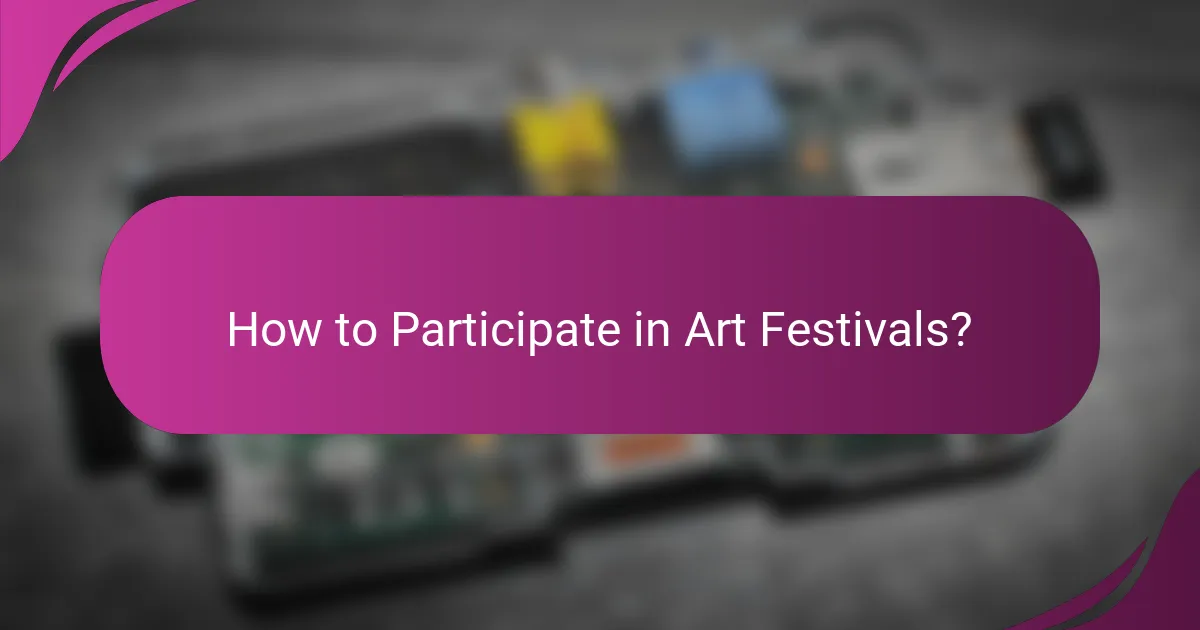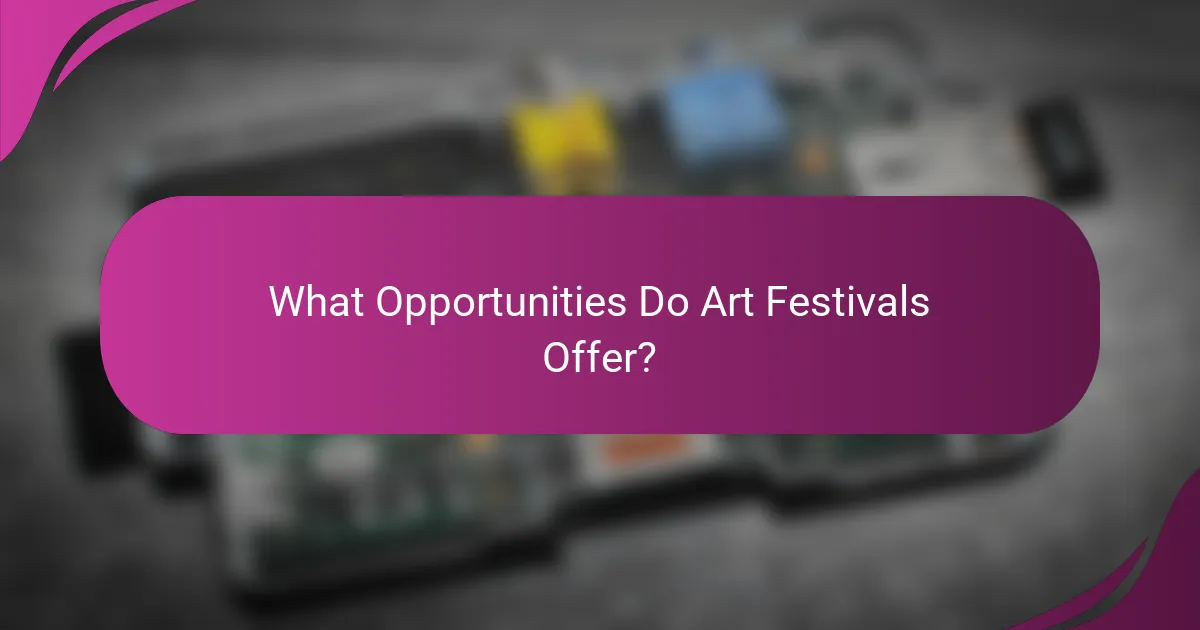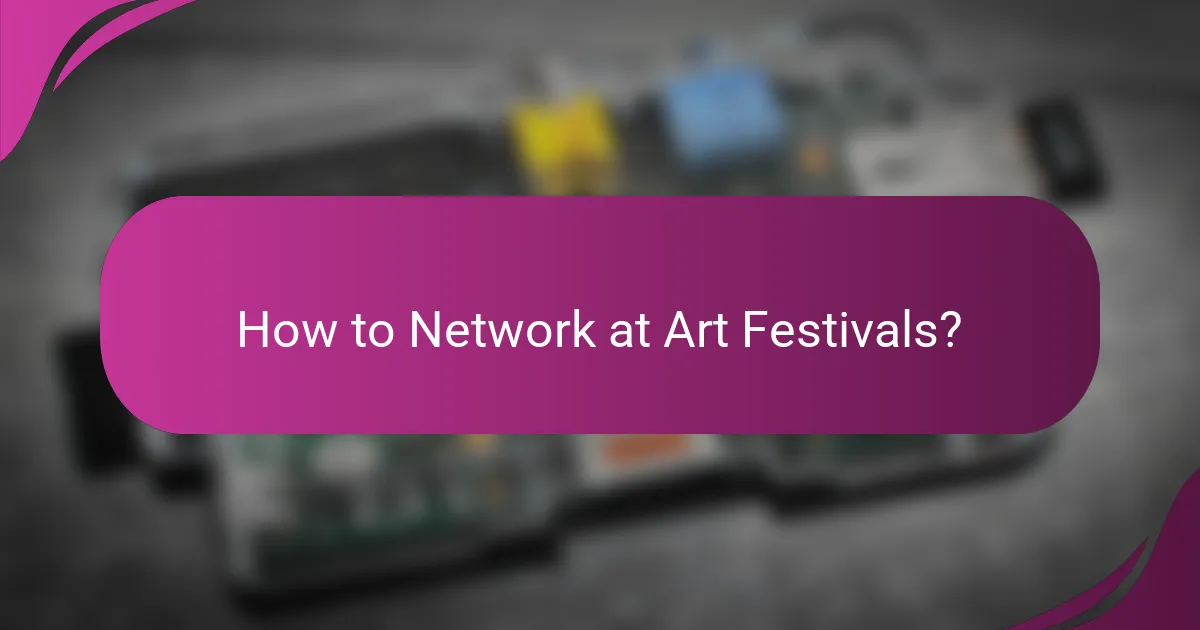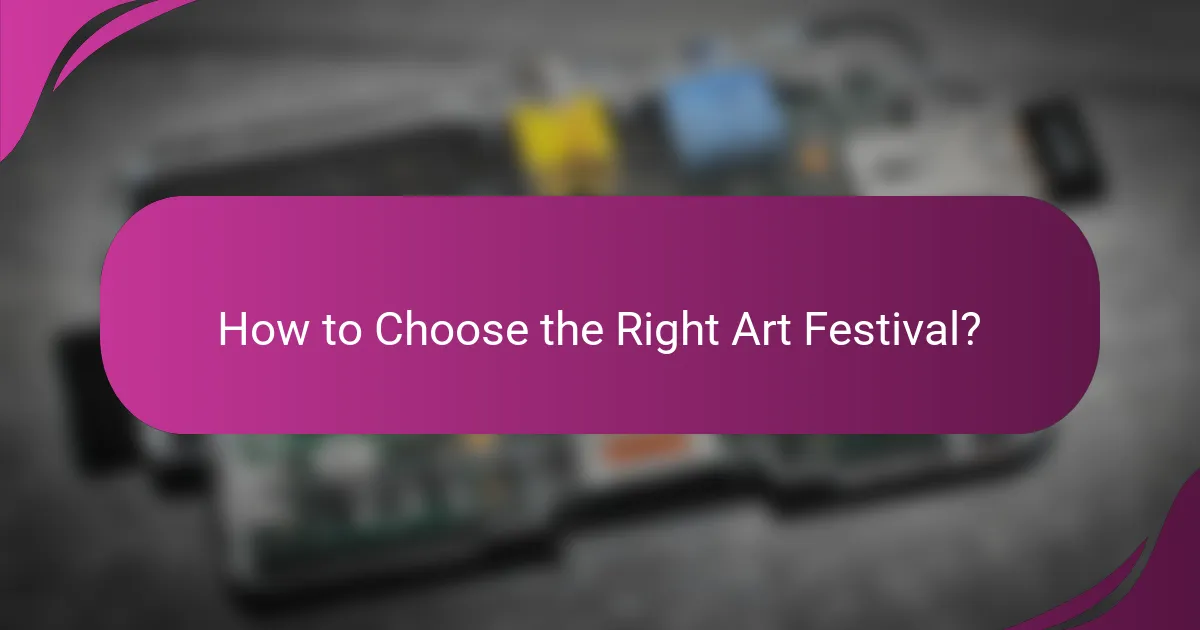Art festivals serve as vibrant platforms for artists to showcase their work, connect with peers, and explore new opportunities. By participating in these events, artists can gain access to exhibition spaces, sales opportunities, and workshops, all while building valuable networks within the art community. Understanding the application process and preparing adequately can significantly enhance an artist’s visibility and career trajectory.

How to Participate in Art Festivals?
Participating in art festivals involves a series of steps including application, meeting eligibility criteria, and preparing necessary materials. Understanding these components can enhance your chances of success and help you make the most of networking opportunities.
Application processes
The application process for art festivals typically begins with filling out an online form or submitting a physical application. Many festivals require artists to provide a portfolio showcasing their work, along with a statement of intent or artist biography.
Some festivals may also conduct interviews or require additional documentation, such as references or past exhibition records. It’s crucial to follow the specific instructions provided by each festival to ensure your application is considered.
Eligibility criteria
Eligibility criteria for art festivals can vary widely, often depending on the festival’s focus, location, and target audience. Many festivals welcome artists from diverse backgrounds, but some may have specific requirements, such as age limits, residency status, or artistic medium.
It’s advisable to review the eligibility guidelines carefully before applying to avoid disqualification. Some festivals may prioritize emerging artists, while others might be open to established professionals.
Submission deadlines
Submission deadlines for art festivals are critical and can range from several months to just weeks before the event. Most festivals publish their deadlines on their websites, often including early bird submission dates that may offer reduced fees.
Marking these dates on your calendar can help you stay organized and ensure you submit your application on time. Late submissions are typically not accepted, so plan ahead to avoid missing out.
Required materials
Required materials for art festival applications usually include a portfolio, artist statement, and CV. Some festivals may also request specific images of your artwork, including high-resolution photos or videos that showcase your work effectively.
Additionally, you might need to provide a proposal for a specific project or installation if the festival focuses on site-specific works. Always check the festival’s guidelines for a complete list of required materials.
Fees and costs
Fees and costs associated with participating in art festivals can vary significantly. Some festivals charge a nominal application fee, while others may require a higher fee that can reach several hundred dollars, especially for larger events.
In addition to application fees, consider potential costs for travel, accommodation, and materials needed for your exhibition. Budgeting for these expenses will help you participate without financial strain.

What Opportunities Do Art Festivals Offer?
Art festivals provide a variety of opportunities for artists, including exhibition spaces, sales avenues, workshops, and collaborative projects. These events facilitate networking and can significantly enhance an artist’s visibility and career prospects.
Exhibition spaces
Exhibition spaces at art festivals allow artists to showcase their work to a diverse audience, including collectors, critics, and the general public. These spaces can vary from individual booths to larger gallery-style setups, depending on the festival’s scale and focus.
When selecting an exhibition space, consider factors such as location, foot traffic, and the festival’s reputation. Participating in well-established festivals can lead to greater exposure and potential sales.
Sales opportunities
Art festivals often provide artists with direct sales opportunities, allowing them to sell their work on-site. This can include original pieces, prints, and merchandise, giving artists a chance to earn income while interacting with buyers.
Pricing artwork appropriately is crucial; consider the festival’s audience and typical price ranges for similar works. Offering a range of price points can attract a broader customer base.
Workshops and classes
Many art festivals host workshops and classes, providing artists with the chance to share their skills and knowledge. These sessions can cover various topics, from techniques to business practices, and can attract participants eager to learn.
Leading a workshop can enhance an artist’s credibility and visibility, potentially leading to future opportunities. Ensure that the content is engaging and tailored to the audience’s skill level for maximum impact.
Collaborative projects
Collaborative projects at art festivals encourage artists to work together, fostering creativity and innovation. These projects can take many forms, such as joint installations, community art initiatives, or performance art pieces.
Engaging in collaborations can expand an artist’s network and introduce them to new techniques and perspectives. Be open to different ideas and approaches to make the most of these collaborative opportunities.

How to Network at Art Festivals?
Networking at art festivals involves engaging with fellow artists, curators, and art enthusiasts to build relationships that can lead to collaboration and opportunities. Effective networking requires preparation, active participation, and follow-up to maintain connections made during the event.
Networking events
Networking events at art festivals provide structured opportunities for attendees to meet and interact. These can include panel discussions, workshops, and informal meet-and-greets. Participating in these events allows you to showcase your work and engage in meaningful conversations with industry professionals.
To maximize your experience, research the schedule ahead of time and identify key events that align with your interests. Bring business cards or a digital portfolio to share your work easily and make a lasting impression.
Social media strategies
Utilizing social media effectively can enhance your networking efforts at art festivals. Before the event, follow relevant hashtags and accounts to stay informed about festival activities and connect with other attendees. During the festival, share live updates, photos, and insights to engage your audience and attract attention.
After the event, continue the conversation by tagging people you met and sharing your experiences. This not only reinforces your connections but also keeps you visible in the art community. Consider platforms like Instagram and LinkedIn, which are popular among artists and art professionals.
Follow-up techniques
Following up after an art festival is crucial for maintaining the connections you’ve made. Send personalized messages to individuals you met, referencing specific conversations or shared interests to remind them of your interaction. A simple thank-you note or a message expressing your enjoyment of their work can go a long way.
Consider scheduling a coffee meeting or a virtual chat to deepen the relationship. Keeping your follow-ups concise and genuine will help you stand out and foster a sense of community among your contacts.

What Are the Benefits of Attending Art Festivals?
Attending art festivals offers numerous benefits, including increased visibility for artists and opportunities for networking. These events create a vibrant atmosphere where creativity thrives, allowing participants to connect with a diverse audience and fellow creators.
Exposure to new audiences
Art festivals provide a platform for artists to showcase their work to a broader audience, which can lead to increased sales and recognition. By participating, artists can engage with art enthusiasts, collectors, and potential buyers who may not have encountered their work otherwise.
Consider setting up interactive displays or live demonstrations to attract attention. This hands-on approach can enhance engagement and leave a lasting impression on festival-goers.
Building professional relationships
Networking is a key advantage of attending art festivals. Artists can meet gallery owners, curators, and other professionals who can help advance their careers. Establishing these connections can lead to future collaborations, exhibitions, or even mentorship opportunities.
To maximize networking, prepare business cards and be open to conversations. Follow up with new contacts after the event to solidify relationships and explore potential partnerships.
Learning from peers
Art festivals often feature workshops, panels, and discussions led by experienced artists and industry experts. These sessions provide valuable insights into current trends, techniques, and best practices within the art community.
Take advantage of these learning opportunities by actively participating and asking questions. Engaging with peers can spark new ideas and inspire your own artistic journey.

How to Choose the Right Art Festival?
Choosing the right art festival involves evaluating its reputation, understanding the target audience, and considering location factors. These elements will help you align your artistic goals with the festival’s offerings and maximize your networking opportunities.
Festival reputation
The reputation of an art festival can significantly impact your visibility and opportunities. Research past participants, awards, and reviews to gauge how the festival is perceived in the art community. A well-regarded festival may attract more influential attendees and collectors.
Consider reaching out to previous participants for firsthand accounts of their experiences. This can provide insights into the festival’s organization, audience engagement, and overall atmosphere.
Target audience alignment
Understanding the festival’s target audience is crucial for ensuring your work resonates with attendees. Look for festivals that cater to your specific art style or medium, whether it be contemporary, traditional, or digital art.
Review the festival’s promotional materials and past exhibitions to identify the demographics of their audience. This can help you determine if your art will appeal to the visitors and potential buyers present at the event.
Location considerations
The location of an art festival can influence both attendance and your logistical planning. Consider factors such as travel costs, accommodation options, and local art scene dynamics when selecting a festival.
Festivals in urban areas may attract larger crowds and more diverse audiences, while those in rural settings might offer a more intimate experience. Evaluate the local art market and community engagement to ensure the festival aligns with your goals.
